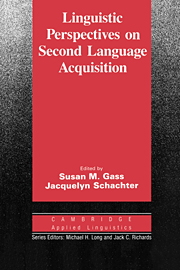Book contents
- Frontmatter
- Contents
- List of contributors
- Series editors' preface
- Introduction
- I THEORIES OF ACQUISITION
- II SYNTAX
- Chapter 3 Testing a proposed universal
- Chapter 4 The role of the head-initial/head-final parameter in the acquisition of English relative clauses by adult Spanish and Japanese speakers
- Chapter 5 On some properties of the “pro-drop” parameter: looking for missing subjects in non-native Spanish
- Chapter 6 The adjacency condition on case assignment: do L2 learners observe the Subset Principle?
- III SEMANTICS/PRAGMATICS
- IV LEXICON
- V PHONOLOGY
- Index
Chapter 5 - On some properties of the “pro-drop” parameter: looking for missing subjects in non-native Spanish
Published online by Cambridge University Press: 05 October 2012
- Frontmatter
- Contents
- List of contributors
- Series editors' preface
- Introduction
- I THEORIES OF ACQUISITION
- II SYNTAX
- Chapter 3 Testing a proposed universal
- Chapter 4 The role of the head-initial/head-final parameter in the acquisition of English relative clauses by adult Spanish and Japanese speakers
- Chapter 5 On some properties of the “pro-drop” parameter: looking for missing subjects in non-native Spanish
- Chapter 6 The adjacency condition on case assignment: do L2 learners observe the Subset Principle?
- III SEMANTICS/PRAGMATICS
- IV LEXICON
- V PHONOLOGY
- Index
Summary
Introduction
The parameterized model of acquisition proposed by Chomsky (1981, 1982) has served as the theoretical framework for a number of studies in the field of second language acquisition, of which Flynn (1987), Phinney (1987), and White (1988) are some recent examples. One of the aims of this research is to find out whether the acquisition device that operates in first language (L1) acquisition continues to operate in the case of second language (L2) acquisition. If that were the case, both L1 and L2 learners would be supposed to set a number of parameters according to the options permitted by Universal Grammar (UG). The question then is whether L2 learners start with their L1 setting of a given parameter and eventually reset it to the L2 option or whether the L1 setting does not play a role in the acquisition process. In other words, we face the traditional problem of the role of the mother tongue in L2 acquisition, but in parameterized terms.
Closely linked to this parametric view of acquisition is the theory of markedness (Chomsky 1981, 1986), which differentiates core from peripheral grammar. Core grammar is the grammar that is determined by fixing the parameters of UG in one of the permitted ways. Peripheral grammar is the set of marked elements and constructions that are outside of core grammar, but still constitute what is actually represented in the mind of an individual. According to the theory of markedness, learners project the core grammar of their language on the basis to the principles and parameters of UG.
- Type
- Chapter
- Information
- Linguistic Perspectives on Second Language Acquisition , pp. 109 - 133Publisher: Cambridge University PressPrint publication year: 1989
- 52
- Cited by



